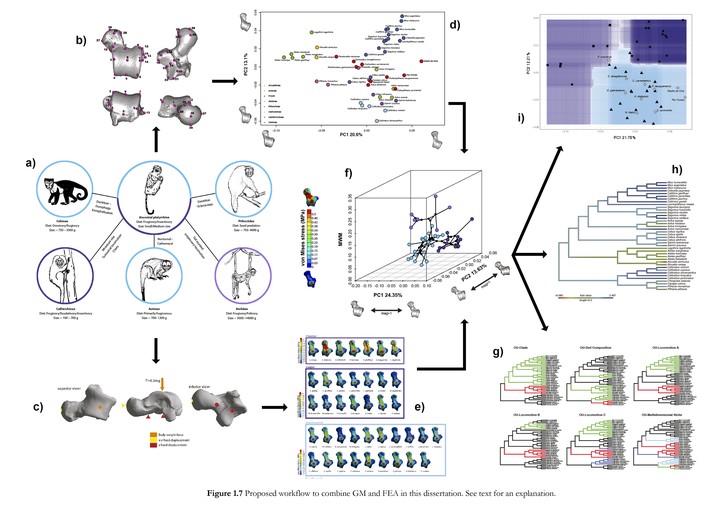Morpho-functional analyses of the primate skeleton applying 3D geometric morphometrics, finite element analysis and phylogenetic comparative methods to assess ecomorphological questions in extant and extinct anthropoids
 Image credit: Thomas A. Püschel
Image credit: Thomas A. Püschel
Abstract
The overarchingobjective of this dissertation is to understand the relationship betweenform and ecological function in diverse skeletal elements belonging to different primate clades using geometric morphometrics (GM), finite element analysis (FEA) andphylogenetic comparative methods (PCMs). GM provides a system for quantifying morphology; while FEA allows measuring biomechanical performance and PCMs are used to model how phenotypic traits have evolved through time. Most chapters in this thesis focus on the association between locomotion and morphology and how to apply this information in the fossil record, while one analyses the form–function relationship in a dietary context. Firstly, a combined approach using FEA and GM is applied to analyse different hominoid scapulae. The obtained results show that there is a significant relationship between scapularshape and its biomechanical performance. Hence at least part of scapular shape variation is due to non-phylogenetic factors. Secondly, it is tested whether there is a sclerocarpic specialization gradient in the mandibular morphology of pitheciids. The results show that there is indeed a relative specialization continuum for some aspects of shape, although the story is more complex from a biomechanical perspective. Subsequently, an analysis of the phenetic affinities of extant platyrrhine tali and their Miocene counterparts is carried out to explain the evolution of talar shape and size in platyrrhines. The results suggest that talar shape diversification can be explained by invoking a model representing a phylogenetic hypothesis in which each platyrrhine family occupied a separate adaptive optimum. Moreover, talar size diversification can be characterised by a multidimensional niche model. Finally, the main locomotor mode of different platyrrhine fossils is inferred by applying a combination of GM, FEA and machine-learning (ML) classification techniques. The ML algorithm applied to both biomechanical and morphometric data categorised most of the fossil sample as arboreal quadrupeds, which is consistent with previous studies. Thus, it is expected to contribute to the understanding of the correlation between form and ecological function, which is not only relevant to appreciate the morphological diversity in extant species, but also because it allows to infer past behaviours infossil taxa.